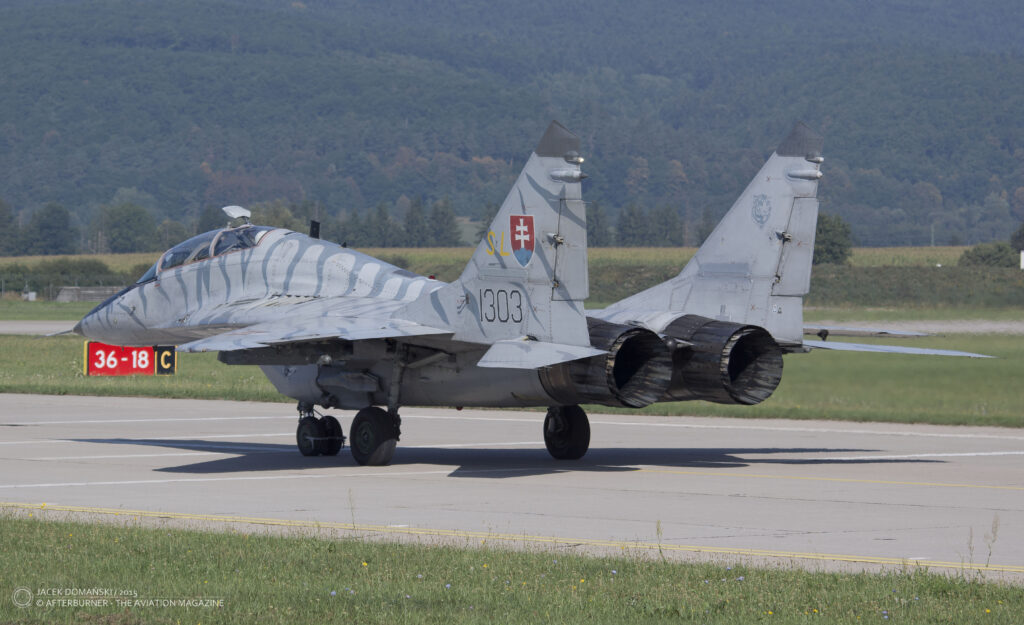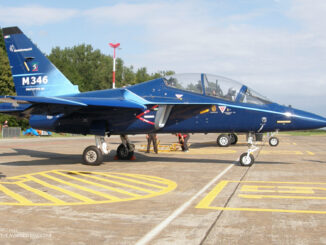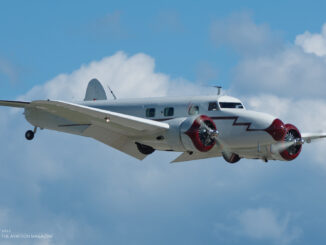 Mikoyan MiG-29 (NATO reporting name ´Fulcrum´), although still being in active service, is usually associated as one of the most iconic aircraft of the late Cold War years. And yet, interestingly, that fighter jet returned on top of the news – mainly because of conflict in Ukraine.
Mikoyan MiG-29 (NATO reporting name ´Fulcrum´), although still being in active service, is usually associated as one of the most iconic aircraft of the late Cold War years. And yet, interestingly, that fighter jet returned on top of the news – mainly because of conflict in Ukraine.
The MiG-29 was developed in the 1970s, by OKB MiG (Mikoyan construction bureau). Prototype of the new Soviet jet performed its maiden flight on 6th October 1977 and in mid-1983, the first MiG-29 aircraft were delivered to training centre in Lipetsk. Among combat units that received the new fighter as the first, there was the 234th Guards Aviation Regiment. That unit was also honoured to have an opportunity to present the MiG-29 abroad. In September of 1986, six ´Fulcrums´ of the 234th Regiment visited Rissala air base in Finland, officially disclosing the MiG-29 outside the Soviet Union.
It should be mentioned here that, initially, the MiG-29 was being developed – according to official Soviet nomenclature from the era – as a ´light frontline fighter´. Therefore, the primary task of that aeroplane was to achieve air superiority over a particular area of armed conflict. And that was reflected in its design. The MiG-29 was able to operate from austere, short runways, was characterized by an excellent agility and manoeuvrability, ability to exceed Mach 2 and to carry heavy air-to-air armament. On the other hand, not enough attention was paid to long service life of particular components of the aircraft, including engines. They had to be durable enough but for a relatively short time – in conditions of an armed conflict, aircraft such as frontline fighters were expected to be worn out quickly.
The first, initial production series of the MiG-29 fighter and ´UB´ two-seat training version, were designated 9-12 and 9-51, respectively. Simplified variants intended for air forces of the Warsaw Pact countries were known as 9-12A and significantly downgraded export version for other countries received a designation 9-12B.
The MiG-29 quickly became relatively popular fighter, no matter the precarious situation of the Eastern Bloc, and the Soviet Union itself, in the end of the 1980s. India was the first foreign operator and acquired the first batch of 9-12B variant already in 1986. Within the Warsaw Pact countries, the ´Fulcrum´ was acquired by Bulgaria, Czechoslovakia, GDR, Poland and Romania. The downgraded version was sold, inter alia, to Yugoslavia, Syria, Cuba or North Korea.
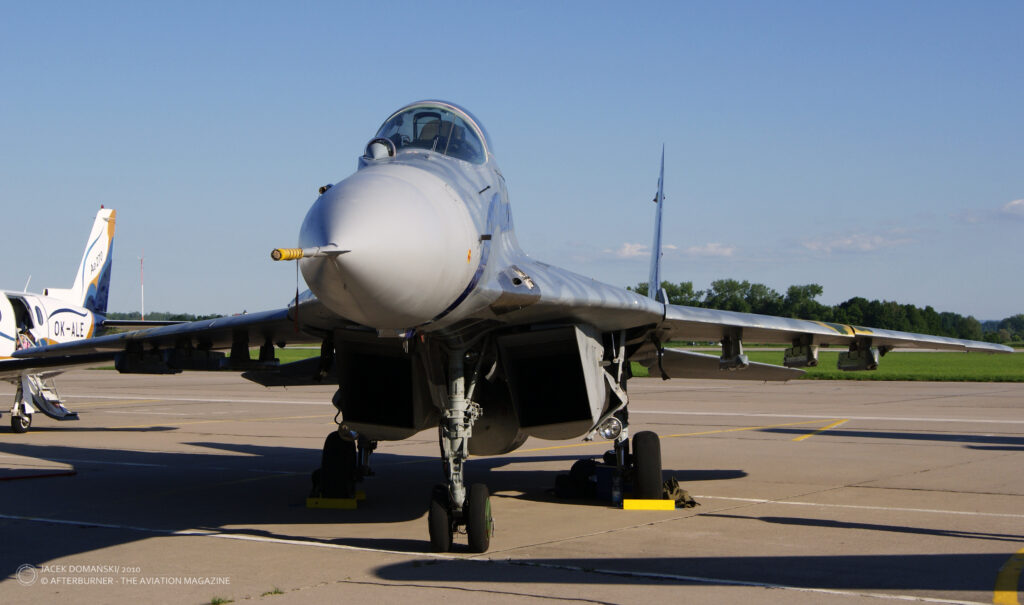
Many of those initial purchase contracts were negotiated and concluded yet during existence of the Soviet Union, but sometimes deliveries were completed in a completely new reality. An interesting fact is, that Hungary acquired 28 aircraft (twenty two 9-12B and six 9-51) only in 1993, so already after dissolution of both the Soviet Union and the Warsaw Pact. Those aircraft were used as partial settlement of Soviet debt to Hungary.
Certainly, production and development of the MiG-29 was not ceased after the year 1991. The aircraft was (and still is) being progressively upgraded over the years. Nevertheless, starting from the 2010s, popularity of the ´Fulcrum´ had declined significantly – even the Russian Aerospace Forces preferred to buy Sukhoi fighters. The latest, remarkably redeveloped variant performed its maiden flight in December of 2016 and currently is officially marketed as MiG-35. However, it failed to gain any significant interest from foreign air forces, despite being heavily advertised as a successor of the MiG-29. Only a few Mi-35 aircraft were bought by the Russian Aerospace Forces, most probably due to political and marketing reasons.
Returning to the ´Fulcrums´ operated by the former Warsaw Pact countries, the Czech Republic was the first to withdraw its MiG-29s – just after three years of their active service. After dissolution of Czechoslovakia, the newly established Czech Air Force inherited ten ´Fulcrums´ but all maintenance facilities were now located in Slovakia. As a consequence, in the late 1995, all the MiG-29 were swapped with Poland for eleven W-3 Sokol helicopters. Germany, despite some investment made to upgrade its MiG-29s into the NATO standards, retired them in 2003. In the same year, the ´Fulcrums´ were withdrawn in Romania and Hungary followed in 2010.
Nevertheless, the MiG-29 is still in active service in Bulgaria, Poland and Slovakia. Although those countries have already joined the Alliance many years ago, their tight military budget did not allow to retire the ´Fulcrums´ as quickly as they would like to.
And here is our brief overview of the MiG-29 service in all of those three abovementioned countries.
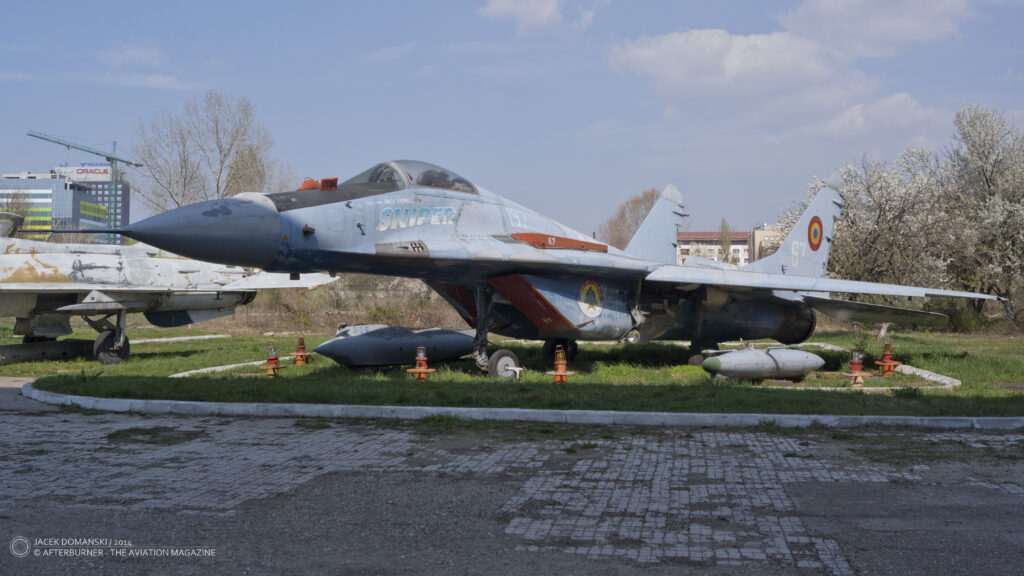
Bulgaria
The Bulgarian Air Force (Военновъздушни сили) received its twenty two ´Fulcrums´ between 1989 and 1990. They included eighteen examples of single-seat MiG-29 (9-12A) and four two-seat MiG-29UB (9-51) aeroplanes. Between the 1990s and 2000s, all those aircraft were intensively exploited, being a backbone of Bulgarian military aviation. Two jets, one MiG-29A and one MiG-29UB were lost in accidents that occurred in 1994 and 2012, respectively.
In 2004, Bulgaria joined the NATO, at that time reporting an inventory of approximately 100 military aircraft. All of them were originated from the Warsaw Pact era and many were not airworthy anymore. The country significantly cut its military budget, got rid of almost all old aircraft and focused its efforts to maintain just a small fleet of MiG-29 and Su-25 jets.
Nevertheless, the 2010s were marked by a significant issues with keeping the Bulgarian MiG-29s airworthy. Complicated, sometimes merely impossible purchase of spare parts from Russia and necessity of frequent repairs of the engines resulted in grounding the majority of Bulgarian ´Fulcrums´. As a consequence, in 2015 the country was even considering to ask Greece and Turkey for supporting the protection of its airspace.
As a conclusion, in February of 2016, the Bulgarian Parliament officially approved the joint national air policing. Since that time, NATO fighters are supporting the Bulgarian Air Force on regular basis, therefore compensating the country´s issues with its fleet of MiG-29 fighters. Among units that were deployed to Bulgaria, there were the 555th Fighter Squadron USAF from Aviano and its F-16s Fighting Falcons, or the Massachusetts and California Air National Guard with their F-15 Eagles.
In the meantime, the Bulgarian authorities have concluded two deals for maintenance and repairs of its MiG-29 fleet. The first one was signed with Poland in 2015 and agreement with Russia followed a year later. However, it seemed that those contracts did not solve all the issues – in 2017, Bulgarian pilots reportedly refused to fly the MiG-29 fighters. According to local press, it was caused by technical condition of the aircraft. In addition, another Bulgarian ´Fulcrum´ was lost in 2021, killing the pilot.
The Bulgarian government continued to improve the maintenance of its fighter fleet. Another contracts were concluded, including the main deal with Russia signed in January 2020. It was worth 4.68 million of USD and the deliveries were concluded in August of 2021.

Since the middle of 2010s, Bulgaria was desperately searching for a replacement of the MiG-29s. The rumours were that Dassault Rafale would be the one but in 2019, the Bulgarian authorities finally asked the US government for a purchase of eight F-16 Fighting Falcon aircraft in Block 70/72 configuration. The contract, worth 1.26 billion USD, was officially assigned to Lockheed Martin in April of 2020. Initially the Vipers had to be delivered between November 2023 and January 2027. In August of 2021, the Bulgarian authorities signed up for another batch of eight F-16 fighters.
It seemed that Bulgaria would finally switch to Western-made fighters next year but, regrettably, in January of 2022 the Bulgarian press announced – quoting the sources in the Bulgarian MoD and Lockheed Martin – that there is an unexpected problem caused by coronavirus pandemic and the delivery of first aircraft is postponed until 2024.
As a result, Bulgaria is forced to keep the MiG-29s airworthy for another few years or, as already mentioned above, to ask the Alliance to extend the air policing duties in the country. Although the agreement concluded with Russia back in 2020 should allow the ´Fulcrums´ to remain airworthy until 2029, there is no guarantee it would be still continued in the future, due to war in Ukraine and related tensions between Russia and NATO. Additionally, it was repeatedly reported that yet before the abovementioned conflict, cooperation with RSK MiG was far from being smooth. Scheduled repairs and maintenance were often postponed, deadlines not met and there was a constant lack of components.
Regarding speculations about currently airworthy MiG-29s in Bulgarian service, their exact number is, obviously, classified. Nevertheless, an information officially disclosed in 2020 mentioned a total of fifteen aircraft in service but the number of really serviceable fighters is still a subject to discussion in Bulgarian and international custom press – usually indicating less then ten fighters in operational condition.
On 29th March, the Bulgarian media widely quoted the statement of the country´s new Minister of Defence, Dragomir Zakov. According to ´Balkan Insight´, when asked about the possibility to support Ukraine with the Bulgarian Mig-29s, Zakov replied that there is no possibility to ´give Ukraine something we do not have´. He also said that Bulgaria is now expecting arrival of Dutch F-35 Lightning II aircraft, as a strengthening of its air defence capabilities.
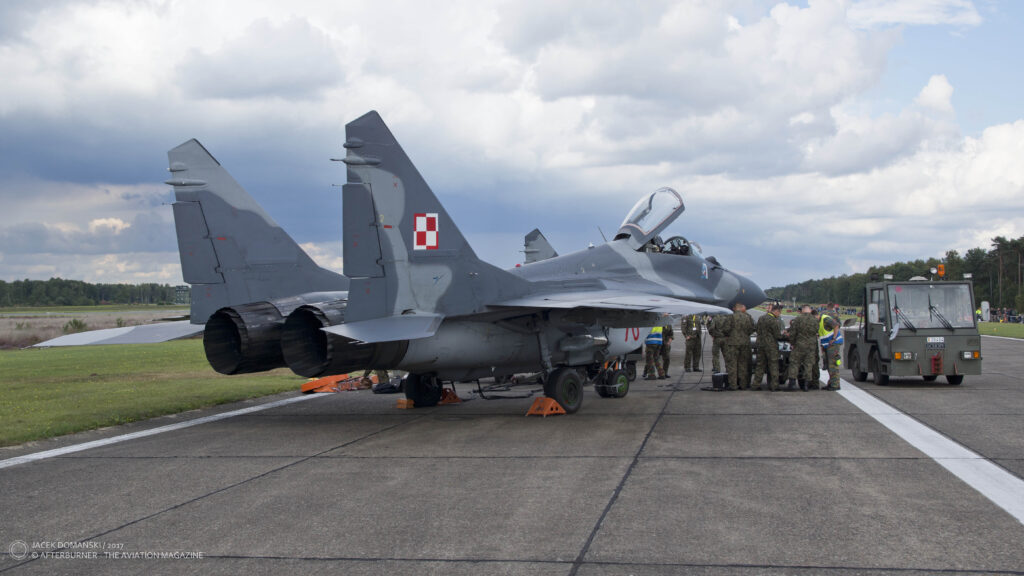
Poland
In 1985, the MiG-29 was for the first time introduced to Polish military authorities. An official display was arranged at Kubinka air base and met with appreciation. Initially, the Polish Air Force (Siły Powietrzne) was interested in acquiring thirty six single-seat and six double-seat aircraft but purchasing the MiG-29s was a subject of long political bargaining within the Polish authorities. Eventually, and only in 1987, the Polish MoD ordered nine MiG-29s and three MiG-29UBs. An order for further five aircraft followed shortly thereafter.
The first four ´Fulcrums´ in 9-12A variant arrived to Poland in July of 1989. They were followed by three 9-51 aircraft in August of the same year and finally further five single-seaters were delivered in October of 1990. All jets were assigned to 1 Pułk Lotnictwa Myśliwskiego (the 1st Fighter Aviation Regiment) in Mińsk Mazowiecki and officially were reported as ´combat ready´ in January of 1992.
Due to changes of the political situation, the Polish authorities made an attempt to reject further deliveries of already ordered MiG-29s. A few months later, the Soviet Union collapsed and the second order for additional five fighters was finally cancelled.
In the meantime, geopolitical situation in the Central Europe was changing very quickly. In October of 1990, the East and West Germany reunified into one state and in January of 1993, Czechoslovakia split into two independent countries. Additionally, Poland and most of the former Eastern Bloc countries were now facing West, aiming to join both the EU and the NATO. This, in turn, caused a significant changes within their air forces that have undergone restructuring and significant reduction.
The first of those changes occurred south of Poland as a consequence of dissolution of Czechoslovakia. Initially, the existing inventory of post-Czechoslovak MiG-29s was divided 50/50 between the newly established Czech and Slovak Air Forces. Each country received nine single-seat fighters and one two-seat training aircraft. Nevertheless, all repair and maintenance facilities were now located on the Slovak territory, therefore bringing the possibility of operational use of the Czech ´Fulcrums´ into question.

At the end of 1992, the Czech Air Force withdrawn all the MiG-29s from air defence duties and then officially retired them in June of 1994. Then the search began for a customer and in the following year an agreement was signed with Poland, covering exchange of the Czech MiG-29s for eleven PZL W-3 helicopters. The aircraft were delivered to Poland at the turn of the year 1995/1996 and also assigned to the 1st Fighter Aviation Regiment. At that moment, the Polish Air Force inventory included 18 single-seat (9-12A) fighters and 4 double-seat (9-51) trainers.
In 1994, Poland joined the Partnership for Peace programme, thus declaring its willingness to join the Alliance in the nearest future. That was also connected with launching of two programmes significantly important for the Polish Air Force. The first was related to acquisition of modern fighter aircraft of the Western provenance, but it was expected to be finalized somewhere in the mid-2010s. Therefore, a modernization of existing ´Fulcrum´ fleet to the Alliance standards was also necessary. On 12th March 1999, Poland joined the Alliance and soon thereafter the first MiG-29s of the Polish Air Force were joined the NATO Integrated Air Defence System (NATINADS).
In 2002, Poland acquired another twenty two MiG-29 aircraft, this time purchasing ´Fulcrums´ being retired from the Luftwaffe – for a symbolic price of 1 EUR per aeroplane. Although German jets were much more exploited than the Czechoslovak ones, their advantage was that they were already modernized to the NATO standards.
Fourteen of the ex-German aircraft were approved for further service and, after undergoing maintenance and additional upgrades, they were assigned to 41 Eskadra Lotnictwa Taktycznego (the 41st Tactical Squadron) in Malbork. The remaining aircraft were used as a source of spare parts.
Over the next few years, the MiG-29s of the Polish Air Force were intensively operated by participating in several multinational exercises, European and domestic air shows, as well as being deployed to the Baltic countries within the NATO Baltic Air Policing (in 2005, 2008, 2010, 2012, 2014 and 2015). This necessitated not only further upgrades but also required a considerable effort to keep them airworthy. At the same time, the number of serviceable aircraft was being gradually reduced.
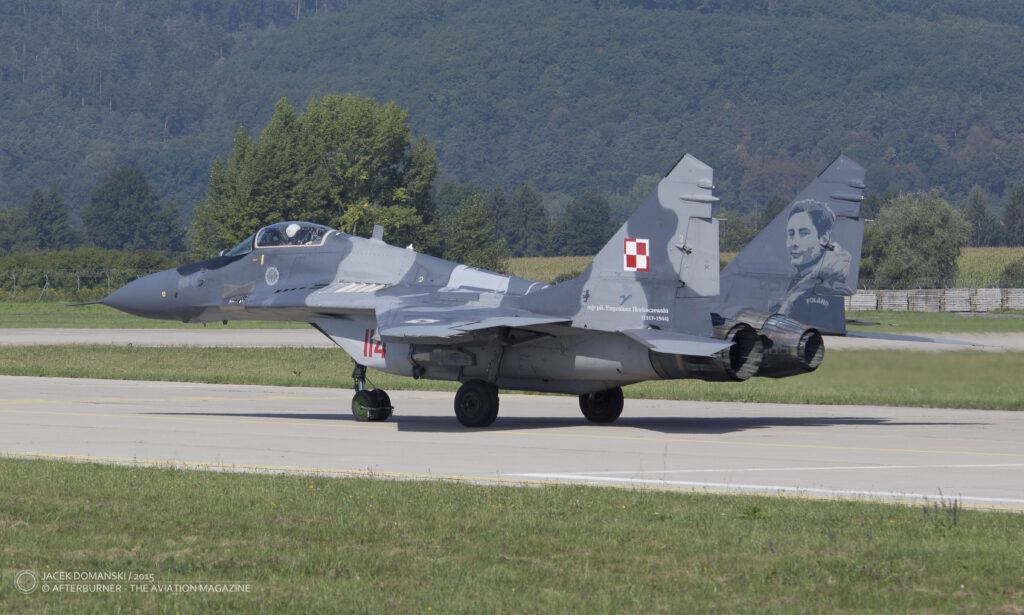
In 2011, the Polish authorities decided about another significant modernization of the MiG-29 fighters. It included implementation of modern avionics suite, data interfaces and mission computer. According to official information released at that time, a total of thirteen single-seat and three double-seat ´Fulcrums´ was a subject of that modernization. The first such upgraded aircraft was delivered to the Polish Air Force in 2013.
It should, however, be recognized that maintenance of the ´Fulcrums´ is one of the greatest problems faced by the Polish Air Force. Although being a long-term issue, that difficulty became even stronger in the 2010s with the increasing tensions between Poland and Russia. In short, Poland was not able to acquire original spare parts directly from Russia and was forced to purchase them from third-party suppliers or use domestically developed and made equivalents.
Between 2016 and 2019, the Polish MiGs suffered from a series of accidents causing a lost of four aircraft and death of one pilot. Regrettably, the tragic event from 2018 resulting with a death of the pilot was a consequence of use domestically made spare parts, that were of different quality. Facing with an aircraft malfunction, the pilot managed to eject but his parachute did not work due to not-original spare part used with the ejection seat system.
This event was at that time broadly commented by the Polish press and operational usefulness of the existing MiG-29s was heavily questioned. According to the media, many of the ´Fulcrums´ were having some technical difficulties and there was also a significant issue with engine maintenance. Nevertheless, the MoD did not join that discussion, classifying almost all information related to those accidents and then, progressively, more and more facts related to the air force and modernization of the Polish armed forces. Finally, the case went cold in late 2019, with the coming of coronavirus outbreak.
Soon thereafter, the Polish government informed about planned acquirement of thirty two F-35 Lightning II aircraft. The delivery contract was officially concluded in 2020 with the first jets expected to be ready in 2024.
According to official releases of the Polish MoD, the MiG-29s are expected to stay in active service until 2028 or until the end of their lifespan, whichever occurs first. The number of airworthy aircraft was officially classified. For the last time, it was disclosed back in 2016 and then thirty two ´Fulcrums´ were declared. Since then, the official statement mentioned only the loss of four aircraft due to accidents.
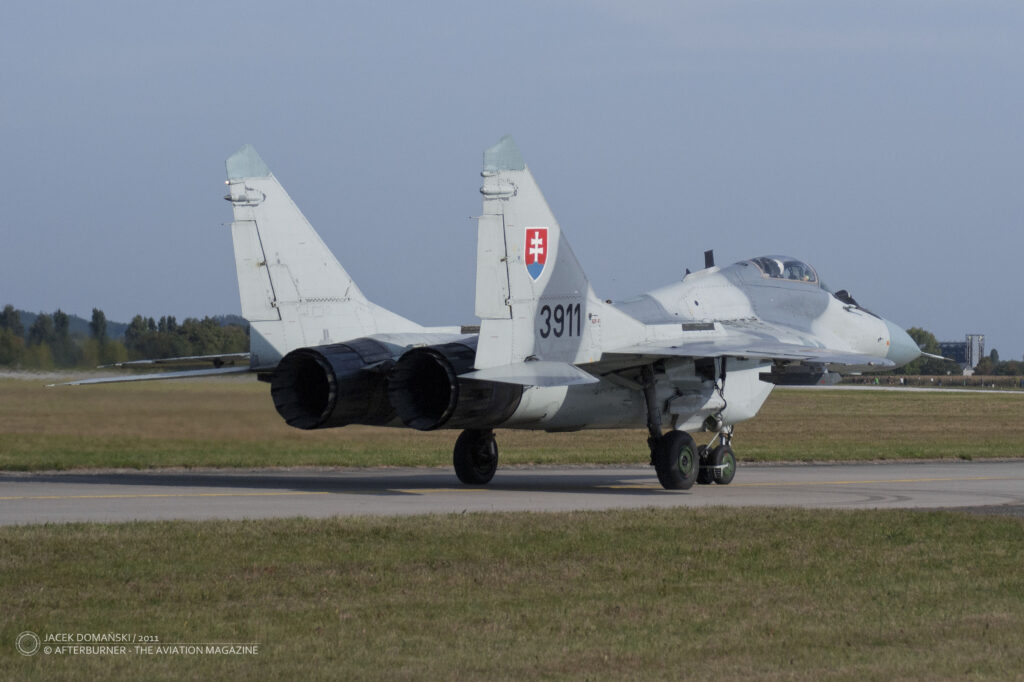
Slovakia
As previously mentioned, the origin of Slovak MiG-29s dates back to the late 1980s and Czechoslovak Air Force.
In April of 1989, the first MiG-29UB arrived to then Czechoslovakia. Further eight single-seat fighters followed in June of the same year and the second double-seat trainer was delivered in August of 1989. Second batch of the aircraft was acquired in 1990, with four MiG-29s arriving in January and further six in April. As usual, the aircraft were delivered in 9-12A and 9-51 variants. All Czechoslovak ´Fulcrums´ were assigned to the 11th Fighter Air Regiment in Žatec.
After the dissolution of Czechoslovakia, the newly established Slovak Air Force (in 1993 – Letectvo a protivzdušná obrana Veliteľstva Armády Slovenskej republiky, currently Vzdušné sily Ozbrojených síl Slovenskej republiky) received the same quantity of the MiG-29 aircraft, as its Czech counterpart – nine single-seat fighters and one trainer.
Between 1993 and 1996, Slovakia received another fourteen MiG-29 jets from Russia. Similarly to Hungarian case, delivery of those aircraft was a part of settlement of the Soviet debt to Slovakia. In the first batch, five single-seat aeroplanes and one trainer were acquired; the second batch included seven fighters and one MiG-29UB.
Nevertheless, the armed forces of new Slovak country suffered a significant financial crisis, especially during fiscal years 1998 and 1999. It caused that the number of airworthy MiG-29 aircraft dropped dramatically. An urgent need to reform the Slovak armed forces was an objective necessity, especially taking in consideration a desire to join the NATO within a few years.
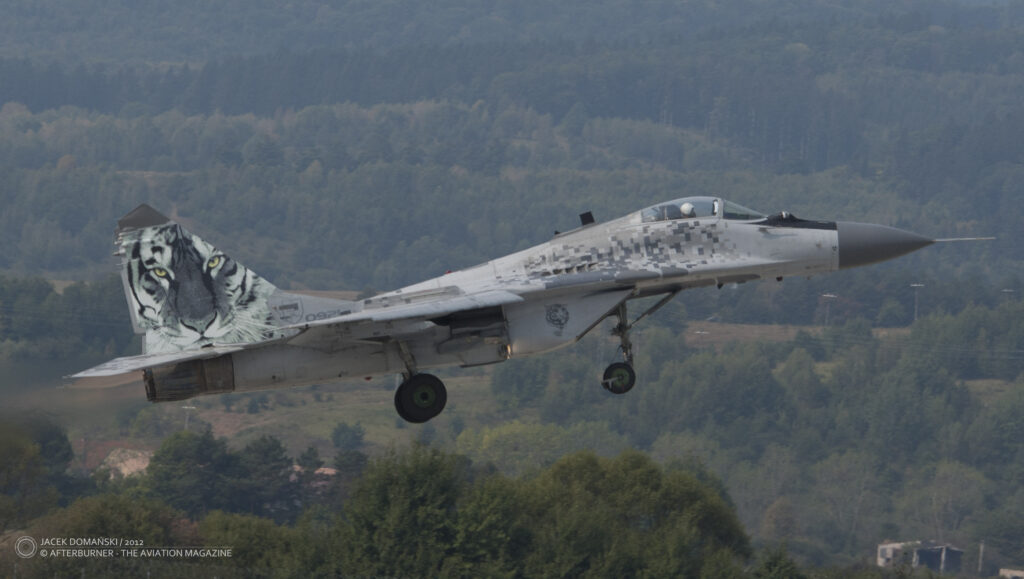
The abovementioned reform of the armed forces was launched in 2000 and four years later, Slovakia officially entered the Alliance. It also meant that Slovak fighters had to be modernized to the NATO standards. The necessary works were executed between 2004 and 2006 by Aviation Repair Plant in Trenčín and included implementation of modern communication systems, NATO navigation and identification systems as well as switching the avionics to imperial units. A total of twelve aircraft was upgraded receiving a new designation MiG-29AS and MiG-29UBS, for single- and double-seat jets, respectively. Some of the modernized aircraft were also distinguished by new, digital camouflage pattern.
In the meantime, the Slovak Air Force lost three MiG-29s, with one fatal casualty. One ´Fulcrum´ was destroyed by fire while remaining on the ground and two other crashed as a result of mid-air collision. All of them were non-modernized aircraft.
Initially, the Slovak authorities planned to keep the MiG-29s in active service until 2029 but shortly thereafter those plans were again modified and the date of 2040 was set. However, relatively quickly it turned out to be merely impossible.
Similarly to Bulgaria (and opposite to Poland) the maintenance of Slovak MiG-29 fleet was secured by an agreement concluded with their manufacturer, the RSK MiG company. And similar issues with quality of the maintenance, spare parts availability and meeting deadlines appeared. They were even intensified by budget cuts.
As a consequence, in the coming years the Slovak fighters suffered from several technical issues and their operational capabilities were persistently questioned. The MiG-29s consecutively lost their interoperability with other NATO aircraft and were not capable of being fully integrated with NATINADS. It was not surprising that number of fighters in service was all the time at a very low level.
It became clear that the Slovak MiG-29s would not be able to stay in active service until 2040, moreover the year 2029 was also questionable. Therefore, the Slovak government opened a discussion on possibility to replace the ´Fulcrums´ with a modern jet, as soon as possible.
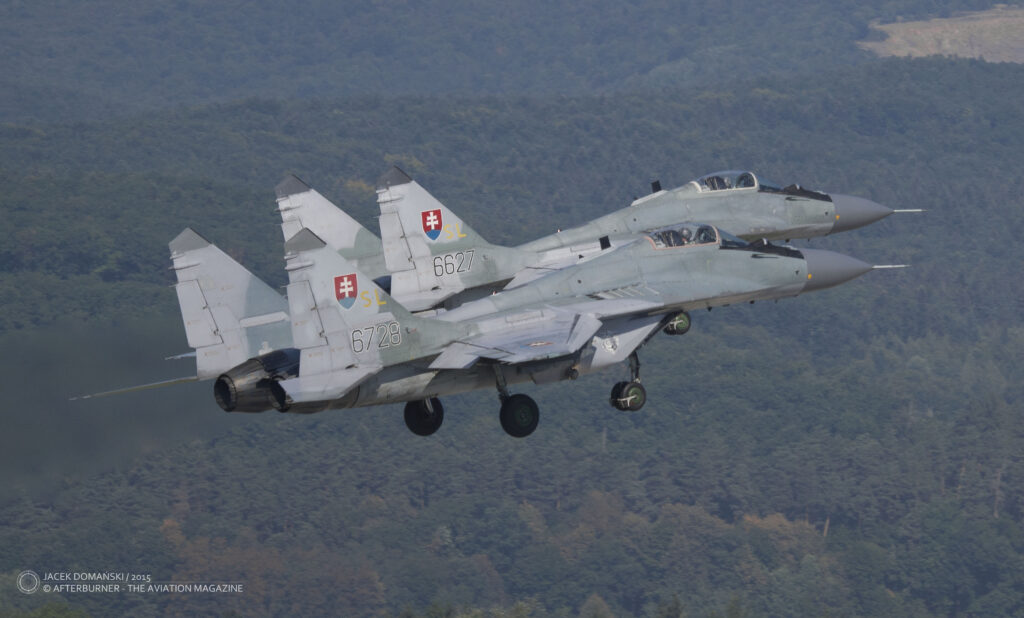
In 2017, the Czech Republic and Slovakia concluded an agreement regarding bi-national cooperation in protecting the airspace of both countries. It allowed, if necessary, the Czech Air Force to operate from Slovak airfields, and vice versa.
One year later, the final decision was made and Slovakia decided to acquire fourteen Lockheed Martin F-16V Block 70/72 fighter aircraft, as a replacement for the MiG-29 fleet. It was expected that first Vipers would arrive to Slovakia in 2022 and thus the ´Fulcrums´ could be retired somewhere in the end of 2023. Regrettably to the Slovak Air Force, the Lockheed Martin company recently informed about postponing the delivery to 2024, due to issues related with coronavirus pandemic.
It might mean that in the nearest future, Slovakia would be compelled to increase the cooperation with the Czech Air Force or use the possibility of Allied air policing. The abovementioned issues with MiG-29s maintenance and their availability may be even broadened by war in Ukraine and following increase of tensions between Russia and the NATO member countries. Similarly to Bulgaria and Poland, the number of currently airworthy ´Fulcrums´ is a subject of speculation in Slovak media. The exact amount is not known, but it seems that six aircraft, being the highest number mentioned recently in the Slovak press, is rather an optimistic estimation.
As a final conclusion, it seems rather clear that the MiG-29 fighters still used by the NATO members are of the low operational value. They are not only thirty-years old aircraft but during their service most of them suffered from difficult technical issues caused by severing ties between those countries and Russia. Locally implemented upgrades and modifications were usually focused just on keeping them airworthy and compatible with the Alliance standards, without any deep modifications of their powerplant or armament systems.
Although still able to serve the Quick Reaction Alert duties or be used for air policing purposes, the MiG-29s could be used in a real combat only with great difficulty. Therefore it is not surprising that Bulgaria, Poland and Slovakia decided to retire the ´Fulcrums´ in the nearest future, already ordering their replacement.
